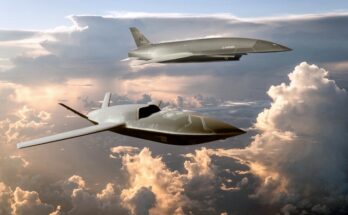
One of Ukraine’s greatest contributions to worldwide warfare observers has been the development and mass usage of uncrewed systems against Russian naval targets. Ukrainian air and naval drones have significantly hampered Russian operations in the Black Sea, offering a playbook for war planners eying conflict scenarios around global maritime chokepoints.
Ukraine’s strategy in the Black Sea was born of combat necessity. At the outset of war in 2022, Kyiv was in no position to challenge Russian preeminence in the Black Sea, having lost its naval headquarters, Sevastopol, to Russian annexation in 2014, and with it a good portion of the surface fleet. Within weeks of Russia’s invasion in late February 2024, the Ukrainian Navy was effectively out of commission.
On March 7, 2022, Ukraine scuttled its flagship Hetman Sahaidachny, fearful that the frigate would fall into Russian hands. While the loss of the surface fleet would be expected to effectively close the maritime dimension of the conflict, Ukraine adapted, relying heavily on missiles and, increasingly, drones to even the battlefield. Both the Navy and the MoD’s Main Directorate of Intelligence (GUR) have employed a legion of uncrewed surface vessels (USVs) and uncrewed air vehicles (UAVs) to hit Russian targets, often pairing the drones with missiles to saturate Russian defenses around Crimea.
Ukraine helped usher in the newest stage of asymmetrical warfare at sea with an attack on Russia’s primary naval base in Sevastopol on October 29, 2022. Seven USVs and nine UAVs attacked the base, reportedly damaging Pr.22350 frigate Admiral Makarov and Pr.266 minesweeper Ivan Golubets. Neither vessel was destroyed as a result, but the operation demonstrated how Ukraine could use the attritable systems to great effect – and at low cost.
These combined drone attacks began as a novelty, but have now become commonplace. And though Russia has worked to improve its defenses against drones threats, a number of the Black Sea Fleet’s ships have fallen victim to Ukrainian strikes. On February 14, 2024, Ukraine used MAGURA V5 USVs to sink Caesar Kunikov, a Pr.775 landing ship. Weeks later, a joint GUR-Navy operation would use five of the same type of drone to destroy Pr.22160 patrol boat Sergey Kotov.
As of early this year, Ukraine estimated that its missile and drone actions had knocked out around a third of the Black Sea Fleet’s vessels – a dramatic setback for Russia, particularly given Moscow’s investment in the fleet’s renewal after 2014. Russia spent the 2010s beefing up its inventory with new frigates, missile boats, and submarines, but has now been forced away from the Ukrainian coast, freeing commercial lanes for Ukrainian exports.
Both tactics and technology continue to evolve. USV operators dodged naval fire and the prey’s own evasive maneuvers to sink Pr.1421 corvette Ivanovets in an overnight attack on January 31. The USVs targeted specific areas of the ship to maximize damage, demonstrating precision. And while the majority of drone strikes have targeted vessels, Ukraine has also worked to damage key Russian infrastructure. Ukraine debuted the Sea Baby USV in July 2023 to carry out an attack on the Kerch Bridge, which connects Russia to occupied Crimea.
Russian efforts to counter USVs, moreover, have spurred further Ukrainian innovation. Footage from Ukrainian attacks show concerted effort on the part of the defenders to destroy the incoming drones, using airborne fires from fighter jets and helicopters to eliminate Ukrainian USVs. In the future, Ukrainian USVs might shoot back – in May, Ukraine showed off a new USV outfitted with two R-73 air-to-air missiles, modified to engage air targets. Ukrainian designers have also toyed with installing tubes to fire Grad rockets, which would enable USVs to bombard positions at a distance.
Strategists around the world have taken note of the changing dynamics at play in the Black Sea and the potential implications for flashpoints elsewhere, for it is no small feat for a small coastal military to effectively deny naval space to a much larger foe, as Ukraine has done. Russia is experimenting with its own USVs, which could be used for detecting and neutralizing Ukrainian ones. Analysts in China’s People’s Liberation Army Navy (PLAN) penned an article in January 2024 highlighting the threat of USVs in combat, demonstrating a keen interest in the Black Sea conflict that is likely reflective of opinions further up the chain in PLAN leadership.
Though an emerging element of warfare, drone swarms are fast becoming a pressing issue for modern navies to deal with – several thousand miles south of the Black Sea, Houthi drone operators have sought to pepper commercial shipping off the coast of Yemen, severely damaging the carrier Tutor in the group’s first successful USV attack just this week.
The battle in the Black Sea is far from won, but serves as a defining moment for the evolution of Ukraine’s maritime force. Chronic underfunding of the Navy forced it to pursue a limited ‘mosquito fleet’ strategic concept after 2014, procuring only a handful of Pr.58155 ‘Gyurza-M’ and Pr.58181 ‘Centaur’ patrol craft that proved woefully inadequate for deterring Russia. The shift towards drone swarms, however, has earned Russian respect, garnering global attention in the process.





